

About Jenkins CI. Jenkins is open-source continuous delivery software.
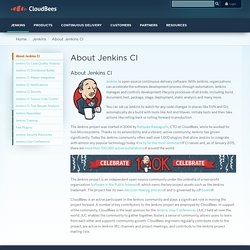
With Jenkins, organizations can accelerate the software development process through automation. Jenkins manages and controls development lifecycle processes of all kinds, including build, document, test, package, stage, deployment, static analysis and many more. You can set up Jenkins to watch for any code changes in places like SVN and Git, automatically do a build with tools like Ant and Maven, initiate tests and then take actions like rolling back or rolling forward in production. The Jenkins project was started in 2004 by Kohsuke Kawaguchi, CTO at CloudBees, while he worked for Sun Microsystems.
Thanks to its extensibility and a vibrant, active community, Jenkins has grown significantly. The Jenkins project is an independent open-source community under the umbrella of a non-profit organization Software in the Public Interest (link is external), which owns the key project assets such as the Jenkins trademark. Continuous Integration with Jenkins. Continuous integration with Jenkins - Tutorial Copyright © 2012-2016 vogella GmbH Jenkins This article describes how to build a continuous integration cycle for Java development with the Jenkins continuous integration build server. 1.

Using the Jenkins build server Continuous integration is a process in which all development work is integrated as early as possible and the resulting artifacts are automatically created and tested. Jenkins is one open source tool to perform continuous integration and build automation. The list of steps can, for example, include: perform a software build with Apache Maven or Gradle Run a shell script Archive the build result Afterwards start the integration tests Jenkins also monitors the execution of the steps and allows to stop the process if one of the steps fails. Jenkins can be extended by additional plug-ins, e.g., for building and testing Android applications or to support the Git version control system. Docker on Synology. Synology and Docker are a great combination, so long as you have purchased the correct platform.
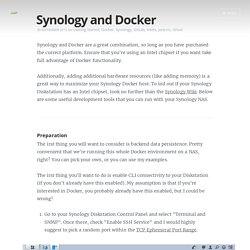
Ensure that you're using an Intel chipset if you want take full advantage of Docker functionality. Additionally, adding additional hardware resources (like adding memory) is a great way to maximize your Synology Docker host. To find out if your Synology Diskstation has an Intel chipset, look no further than the Synology Wiki. How to Run Application in Docker on Synology. When you want to run your application in Docker on Synology you are not allowed to use all of the available parameters of the docker run command.
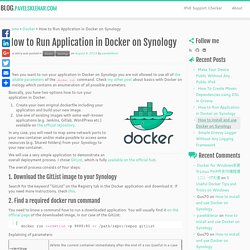
Check my other post about basics with Docker on Synology which contains an enumeration of all possible parameters. Basically, you have two options how to run your application in Docker. Create your own original dockerfile including your application and build your new image.Use one of existing images with some well-known applications (e.g.
Jenkins, Gitlab, WordPress etc.) available on the official repository. In any case, you will need to map some network ports to your new container and/or make possible to access some resources (e.g. We will use a very simple application to demonstrate an overall deployment process. The overall process consists of four steps: 1. Search for the keyword “GitList” on the Registry tab in the Docker application and download it. How to install and use Docker on Synology. 1.
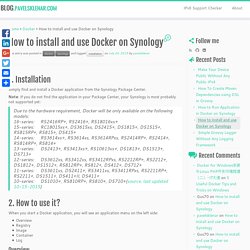
Installation Simply find and install a Docker application from the Synology Package Center. Docker for Dummies? Wildkiwi wrote:I too have successfully installed images and containers.

In this case it is crramirez/limesurvey one. It is started up but I am having issues working out the URL (internal and external) should look like to access it.Can anyone shed a little light on this part of the process please? Have a look at the Dockerfile. Find this line: Code: Select all. Package Bliss as a QPKG for easy installation on QNAP NAS devices, where all my music is :) – Customer Feedback for bliss. I can confirm that Bliss works in the QNAP Container host, and the set-up process is pretty straight forward.
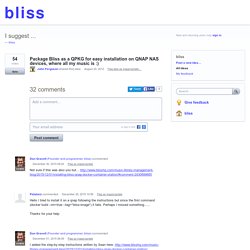
The steps I used are listed below - any improvements or suggestions welcome as this was my first shot at configuring a container... BTW: It would be handy if there was a standard URL for fetching the latest Bliss install jar file - e.g. Installing bliss in a QNAP Docker container - bliss. After three years of waiting for a bliss QNAP package, two turn up at once!
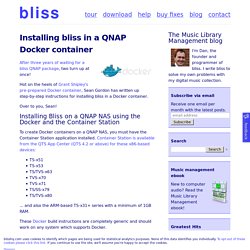
Hot on the heels of Grant Shipley's pre-prepared Docker container, Sean Gordon has written up step-by-step instructions for installing bliss in a Docker container. Over to you, Sean! To create Docker containers on a QNAP NAS, you must have the Container Station application installed. [4.2 Container Station 0 1.0] My cookbook (draft 3 updated) - Page 2 - QNAP NAS Community Forum. Hi, gt.guybrush wrote:i need it remotelyreal problem was lag: 1-2 sec to see reaction to my input, while using qts all works fine, so the hope in something working in qts.p.s.i can give a try to x11vnc but it's a lot of work since i have to setup a ssh server on nas for ssh tunneling, as i do last time on pc. but i think at this as workaround not as a real solution It's not really the subject of this thread ... please open a new one ...
![[4.2 Container Station 0 1.0] My cookbook (draft 3 updated) - Page 2 - QNAP NAS Community Forum](http://cdn.pearltrees.com/s/pic/th/container-cookbook-community-124379602)
I don't know ANY solution that can be faster than X, Vnc por RDP remote ... so I don't understand what is the tools you need ...... ssh + tunnel ... add some overload ... even ... networks IS the bottleneck in case of low response ...... Docker run reference. Docker runs processes in isolated containers.
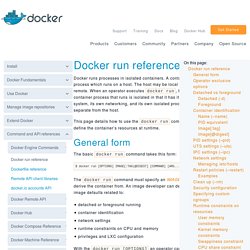
A container is a process which runs on a host. The host may be local or remote. When an operator executes docker run, the container process that runs is isolated in that it has its own file system, its own networking, and its own isolated process tree separate from the host. This page details how to use the docker run command to define the container’s resources at runtime. General form. What are the benefits of Container Station on your QNAP NAS. QNAP network attached storage (NAS) devices give you more than the ability to store your digital content on one box. Over the years, new features and apps have been released allowing users to find that their NAS has so much more to offer, from accessing and running hundreds of apps to turning your NAS device into a virtual PC. With QNAP offering a range of NAS devices for all scenarios, it is the perfect choice for a home users and enterprises alike.
Docker Toolbox Setup – Windows. With the release of Docker 1.8, Windows users who have been learning Docker using Boot2Docker VM Tool, need to learn a few new concepts to get their environment in place for their Docker learning journey. The guide below presents how to get the Docker Toolbox Setup on Windows and the general concepts behind Docker Machine, so that if you have been familiar with Boot2Docker before, your journey is a smooth. If this is what your first time installing the Docker toolchain on your Windows box, then you have come to the right place too! Download the Installer.
Docker - Beginner's tutorial. Docker is a relatively new and rapidly growing project that allows to create very light “virtual machines”. The quotation marks here are important, what Docker allows you to create are not really virtual machines, they’re more akin to chroots on steroids, a lot of steroids. In this tutorial we'll explore what Docker can do for you and how does it do what it does.
Before we continue, let me clear something up. As of right now (4th of January of 2015) Docker works only on Linux, it cannot function natively on Windows or OSX. I’ll be talking about the architecture of Docker later on and the reason will become obvious. The Hitchhiker's Guide to Docker and Modulus - Envato Tuts+ Code Tutorial. Docker Tutorial Series. Docker : Learning Resources.